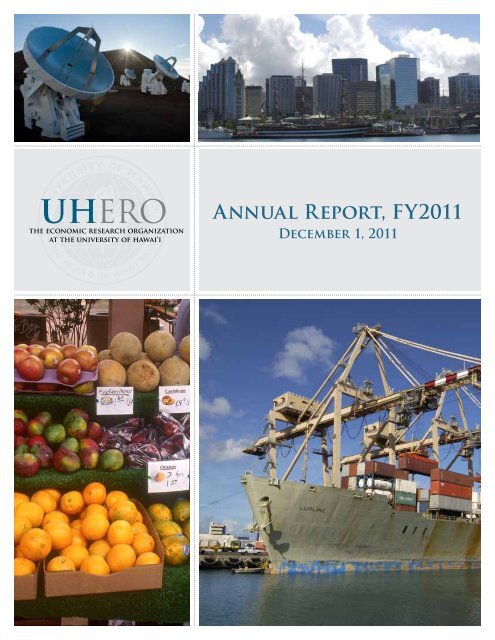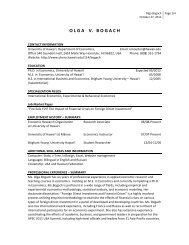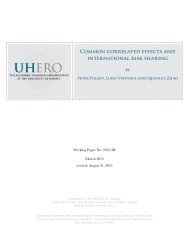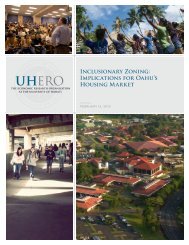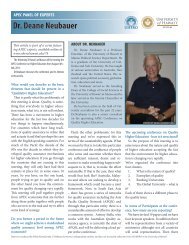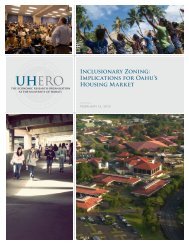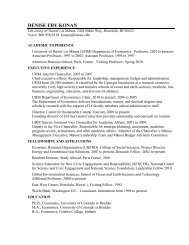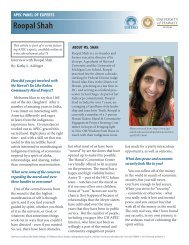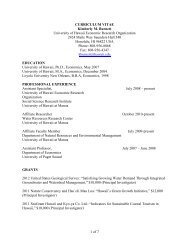Annual Report, FY2011 - UHERO - University of Hawaii
Annual Report, FY2011 - UHERO - University of Hawaii
Annual Report, FY2011 - UHERO - University of Hawaii
Create successful ePaper yourself
Turn your PDF publications into a flip-book with our unique Google optimized e-Paper software.
<strong>Annual</strong> <strong>Report</strong>, <strong>FY2011</strong><br />
December 1, 2011
December 1, 2011 2<br />
<strong>UHERO</strong> <strong>Annual</strong> <strong>Report</strong>, <strong>FY2011</strong><br />
©2011 <strong>University</strong> <strong>of</strong> Hawai‘i Economic Research Organization.<br />
All rights reserved.<br />
2424 Maile Way, Room 540 • Honolulu, Hawai‘i 96822<br />
(808) 956-7605 • uhero@hawaii.edu<br />
uhero.hawaii.edu
December 1, 2011 3<br />
Message from the Executive Director<br />
The past year has brought the beginnings <strong>of</strong> growth to the <strong>Hawaii</strong> economy and fresh new developments for <strong>UHERO</strong>. We have<br />
undertaken important new research, we have added two new faculty members to the <strong>UHERO</strong> team, and we have presented a new<br />
award-winning public face to the community.<br />
This summer we were lucky enough to welcome Dr. Peter Fuleky and Dr. Inna Cintina to the <strong>UHERO</strong> team. Dr. Fuleky holds<br />
a Ph.D in Economics from the <strong>University</strong> <strong>of</strong> Washington, and was most recently a Postdoctoral Fellow with <strong>UHERO</strong>. He brings<br />
expertise in simulation-based estimation, indirect inference, and mixed frequency time series analysis to <strong>UHERO</strong>. Dr. Fuleky is<br />
a joint hire with the Department <strong>of</strong> Economics, where he will teach graduate and undergraduate forecasting and econometrics<br />
courses. Dr. Cintina received her Ph.D in Economics from Clemson <strong>University</strong> in May <strong>of</strong> 2011, and brings a diversity research<br />
interests to <strong>UHERO</strong>, including labor economics, health economics, economics <strong>of</strong> education, and public policy. These young additions<br />
to the <strong>UHERO</strong> family will round out a diversity <strong>of</strong> possibilities for new research related to <strong>Hawaii</strong>’s economy.<br />
<strong>UHERO</strong> is constantly improving and expanding website features to make www.uhero.hawaii.edu an excellent resource for its<br />
users and visitors, and is proud to announce that the website received the Association for <strong>University</strong> Business and Economic Research’s<br />
(AUBER) 2011 Website Award. The AUBER Website Award honors the center whose website effectively and efficiently<br />
communicates with its constituents in terms <strong>of</strong> design, content, organization and more. Recent additions to the website include a<br />
new chart gallery, the <strong>UHERO</strong> Blog, with the latest analysis <strong>of</strong> the Hawai’i economy and the addition <strong>of</strong> the <strong>UHERO</strong> forum on<br />
Facebook. An important feature <strong>of</strong> the website is the <strong>UHERO</strong> Data Portal, a free online resource that provides access to the most<br />
up to date information on a wide array <strong>of</strong> economic and social indicators for the State and County economies. The Data Portal is<br />
made possible through the generous support <strong>of</strong> sponsors, including lead support from the Bank <strong>of</strong> <strong>Hawaii</strong>. This support is a key<br />
factor in <strong>UHERO</strong>’s ability to maintain the high quality level <strong>of</strong> research and service that it does. Content from weekly <strong>UHERO</strong><br />
appearances on KITV, and forecast report summaries available for public viewing can be accessed on the site as well.<br />
In the 2011 fiscal year, we made new strides in economic research that will inform policymaking in <strong>Hawaii</strong> in coming years. This<br />
research builds on our core strengths in the analysis <strong>of</strong> economic, environmental, and human resource issues, while extending our<br />
activities in exciting new directions. One example is research conducted by our Energy and Greenhouse Gas Solutions (EGGS)<br />
team, led by Dr. Denise Konan, which looks at the determinants <strong>of</strong> <strong>Hawaii</strong>’s greenhouse gas emissions and potential policy<br />
responses. Project Environment continues environmental studies on sustainable tourism in <strong>Hawaii</strong>, characterizing the natural<br />
resource management sector in <strong>Hawaii</strong>, the impacts <strong>of</strong> invasive species such as Ohia rust, costs and benefits <strong>of</strong> rodent eradication,<br />
sustainable management <strong>of</strong> <strong>Hawaii</strong>’s groundwater aquifers and forests, and economic determinants <strong>of</strong> introductions <strong>of</strong> invasive<br />
species around the world. New topics under the Forecast Project include research on mixed-frequency models <strong>of</strong> visitor spending<br />
and the role that airfare movements play in determining the number <strong>of</strong> visitor to the state. The common theme across all <strong>UHERO</strong><br />
research is policy relevance—what can we learn about our state and our world that can support better policy decision making?<br />
Overall, during <strong>FY2011</strong> nine <strong>UHERO</strong> faculty or fellows served as PIs on over 20 funded projects resulting in approximately $1.6<br />
million in funding. These funds supported four staff members, and they also supported <strong>UHERO</strong>’s central educational mission.<br />
<strong>UHERO</strong> provided financial support and opportunities for eleven graduate assistants, and we were able to support three undergraduate<br />
interns, who received real world research experience.<br />
The <strong>UHERO</strong> Forecast Project, headed by Dr. Byron Gangnes, continued to play a crucial role over the past year providing detailed<br />
forecasts that help businesses, policy makers and the public make plans in an uncertain economic environment. <strong>UHERO</strong><br />
researchers provided hundreds <strong>of</strong> hours <strong>of</strong> commentary to the press and presentations to civic groups and policymakers. Led by<br />
1<br />
This report focuses on research initiatives underway during <strong>FY2011</strong>. As result, the dollar amounts reported here include some funds awarded in earlier periods.<br />
uhero.hawaii.edu
December 1, 2011 4<br />
Dr. Sumner La Croix, we continued our weekly “<strong>UHERO</strong> <strong>Report</strong>,” segments on KITV news, providing accessible explanation<br />
and analysis <strong>of</strong> emerging economic issues that we hope will build broader understanding throughout the local community.<br />
We feel privileged to be able to play the role we do in <strong>Hawaii</strong>, and we feel blessed to enjoy the support <strong>of</strong> the <strong>University</strong> <strong>of</strong> <strong>Hawaii</strong><br />
and our generous Sponsors too numerous to mention (but see the list on page 4.) We look forward to your continuing support over<br />
the coming year.<br />
With Aloha,<br />
Dr. Carl S. Bonham, Executive Director<br />
uhero.hawaii.edu
uhero thanks the following sponsors:<br />
Kaweki‘u - the topmost summit<br />
The Bank <strong>of</strong> <strong>Hawaii</strong><br />
Kilohana - a lookout, high point<br />
<strong>Hawaii</strong> Electric Light Company. Ltd.<br />
<strong>Hawaii</strong>an Electric Company, Inc.<br />
Maui Electric Company, Ltd.<br />
County <strong>of</strong> Kaua‘i Office <strong>of</strong> Economic Development<br />
Kamehameha Schools<br />
Matson Navigation Company<br />
Kuahiwi - a high hill, mountain<br />
American Savings Bank<br />
Central Pacific Bank<br />
Hau`oli Mau Loa<br />
<strong>Hawaii</strong> Foreign-Trade Zone<br />
Kaiser Permanente Hawai`i<br />
Natural Energy Laboratory <strong>of</strong> <strong>Hawaii</strong> Authority<br />
The Nature Conservancy, <strong>Hawaii</strong>`i Program<br />
The Pacific Resource Partnership<br />
Servco Pacific, Inc.<br />
Kulia I Ka Nu‘u (literally “Strive for the summit”) is the value <strong>of</strong> achievement, those who pursue personal<br />
excellence. This was the motto <strong>of</strong> Hawai‘i’s Queen Kapi‘olani. Sponsors help <strong>UHERO</strong> to continually reach<br />
for excellence as the premier organization dedicated to economic research relevant to Hawai‘i and the Asia<br />
Pacific region.<br />
The <strong>UHERO</strong> Forecast Project is a community-sponsored research program <strong>of</strong> the <strong>University</strong> <strong>of</strong> Hawai‘i at<br />
Mānoa. The Forecast Project provides the Hawai‘i community with analysis on economic, demographic, and<br />
business trends in the State and the Asia-Pacific region.<br />
All sponsors receive the full schedule <strong>of</strong> <strong>UHERO</strong> reports, as well as other benefits that vary with the level<br />
<strong>of</strong> financial commitment.<br />
For sponsorship information, browse to http://www.uhero.hawaii.edu.
December 1, 2011 6<br />
<strong>UHERO</strong>’s mission<br />
<strong>UHERO</strong>’s mission is to inform public- and private-sector economic decision-making through quantitative and analytical research<br />
with a particular focus on the economies <strong>of</strong> Hawai’i and the Asia-Pacific region. <strong>UHERO</strong> provides a forum for interaction between<br />
scholars, public policy makers and business leaders on economic policy choices and facilitates the collaborative efforts <strong>of</strong><br />
UH economists with other scholars. <strong>UHERO</strong> research associates support this mission by conducting substantive research which<br />
is widely disseminated to the public.<br />
The uhero team<br />
<strong>UHERO</strong> faculty includes Carl Bonham, Kimberly Burnett, Peter Fuleky, and Inna Cintina. <strong>UHERO</strong> staff includes Shih-Ling<br />
Chang, Craig Coleman, Ben Trevino, and Christopher Wada.<br />
<strong>UHERO</strong> Research Fellows are the Principal Investigators and Co-PIs on extramurally funded research projects administratively<br />
supported by <strong>UHERO</strong>. Research Fellows participate in <strong>UHERO</strong> governance and share administrative costs and benefits. Current<br />
Research Fellows include Makena C<strong>of</strong>fman, Byron Gangnes, Denise Konan, Sumner LaCroix, Sang-Hyop Lee, John Lynham,<br />
and James Roumasset.<br />
<strong>UHERO</strong> Affiliate Researchers are engaged in research or service that supports <strong>UHERO</strong>’s mission. Current Affiliate Researchers<br />
include Paul Bernstein, Tim Halliday, Hui He, James Mak, Ilan Noy, Katerina Sherstyuk, and Nori Tarui.<br />
<strong>UHERO</strong> graduate research assistants include Lauren Armstrong, Chris DeVenecia, Aaron Mann, Olga Moulton, Iman Nasseri,<br />
Babak Saadat, Atsushi Shibata, Kanae Tokunaga, Sherilyn Wee, Cynthia Ying, and Qianxue Zhao.<br />
<strong>UHERO</strong> undergraduate research interns are James Jones, Jonathan Fung, and Candace Skinner.<br />
uhero.hawaii.edu
December 1, 2011 7<br />
Generous support from <strong>UHERO</strong>’s Sponsors and Subscribers: $149,100<br />
In <strong>FY2011</strong> there were sixteen subscribers to one or more Forecast Project report, and eleven sponsors. Full reports were also<br />
circulated to <strong>University</strong> leaders, state legislators and several cooperating researchers.<br />
The Forecast Project<br />
Current awards: $161,404<br />
Under the direction <strong>of</strong> Dr. Byron Gangnes, <strong>UHERO</strong>’s<br />
Forecast Project undertakes research and analysis on the operation<br />
<strong>of</strong> the <strong>Hawaii</strong> economy and key policy challenges.<br />
The Forecast Project provides the <strong>Hawaii</strong> community with<br />
information and forecasts <strong>of</strong> economic, demographic, and<br />
business trends in the State and the Asia-Pacific region. The<br />
Forecast Project reporting schedule includes quarterly forecast<br />
updates for the <strong>Hawaii</strong> economy, an annual forecast report for<br />
the county economies, a semi-annual construction report, and<br />
an annual global outlook report. The <strong>UHERO</strong> Data Portal<br />
provides public access to an extensive collection <strong>of</strong> relevant<br />
economic statistics.<br />
Over the years, <strong>UHERO</strong> research associates have completed<br />
a wide range <strong>of</strong> studies assessing economic performance<br />
and policy issues for <strong>Hawaii</strong>. These have included methodological<br />
inquiries into issues such as appropriate forecasting<br />
techniques for tourism and methods for evaluating the impact<br />
<strong>of</strong> tax and expenditure programs. <strong>UHERO</strong> has also studied<br />
the potential impact <strong>of</strong> external economic shocks, such as the<br />
9/11 terror attacks. Forecast Project research recognizes the<br />
unique features <strong>of</strong> the local economy including the key role <strong>of</strong><br />
tourism, <strong>Hawaii</strong>’s links with developing Asia, and the role <strong>of</strong><br />
the state’s dynamic construction and service sectors.<br />
Significant funded research during <strong>FY2011</strong> included<br />
(names <strong>of</strong> Principal Investigators are given in parentheses):<br />
Economic Forecasting for State <strong>of</strong> <strong>Hawaii</strong> and its<br />
four counties, <strong>Hawaii</strong>an Electric Company, Inc. (Bonham/Gangnes).*<br />
2011 marks the thirteenth year <strong>of</strong> UHE-<br />
RO’s relationship with <strong>Hawaii</strong>an Electric Company. Since<br />
1998, we have provided long-run economic forecasts used as<br />
inputs into long run planning and sales forecasts for Oahu,<br />
Maui, and <strong>Hawaii</strong> islands.<br />
<strong>UHERO</strong> Data Portal (Bonham).* The <strong>UHERO</strong> Data<br />
Portal is a free online resource that provides access to a wide<br />
array <strong>of</strong> economic and social indicators for the State and<br />
County economies. During the past fiscal year, <strong>UHERO</strong> researchers<br />
and staff worked very hard on a complete redesign<br />
<strong>of</strong> the <strong>UHERO</strong> data portal. The redesigned site includes more<br />
attractive, easier to use graphs and tables, more data, and an<br />
overall new look and feel. This work is now supported by a<br />
generous contribution from The Bank <strong>of</strong> <strong>Hawaii</strong>. The Bank’s<br />
three-year $120,000 commitment will allow for continued<br />
improvement in functionality and coverage <strong>of</strong> the <strong>UHERO</strong>/<br />
Bank <strong>of</strong> <strong>Hawaii</strong> online data portal.<br />
Metropolitan Area Home Price Forecasting for<br />
more than 300 metro areas in US (quarterly), LPS Applied<br />
Analytics Valuation Solutions (Bonham).* UHE-<br />
RO continues to provide metropolitan home prices forecasts to<br />
LPS for use by their clients and as inputs into their valuation<br />
and scoring for structured mortgage products.<br />
Kauai County Online Data book project, plus economic<br />
forecasts, County <strong>of</strong> Kauai Office <strong>of</strong> Economic<br />
Development (Gangnes/Bonham).*<br />
Estimating Visitor Demand, SeaGrant (Bonham)*<br />
This research is prompted by the record high oil prices during<br />
the summer <strong>of</strong> 2008. This surge in fuel prices and the corre-<br />
uhero.hawaii.edu
December 1, 2011 8<br />
sponding rise in airfares is <strong>of</strong>ten cited as an explanation for the<br />
decline in visitor arrivals to <strong>Hawaii</strong> during 2008. Yet the academic<br />
tourism literature has little to say about the actual impact<br />
<strong>of</strong> changing airfares on travel demand. This is partly due<br />
to the lack <strong>of</strong> reliable data on airfares. Using newly available<br />
airfare data from the U.S. Department <strong>of</strong> Transportation, Bureau<br />
<strong>of</strong> Transportations Statistics (BTS). We calculate average<br />
air fares paid from each state in the nation to <strong>Hawaii</strong> using<br />
the DB1BMarket table from BTS. We combining the airfare<br />
data with other data relevant for modeling tourism demand to<br />
<strong>Hawaii</strong> by state, and apply state <strong>of</strong> the art panel methods to<br />
estimate air fare price elasticities for <strong>Hawaii</strong> travel demand.<br />
Sustainable Coastal Tourism, SeaGrant (Konan)*<br />
Tourism has a tremendous impact on the people <strong>of</strong> Hawai‘i<br />
and its environment. Visitor expenditures in 2007 comprised<br />
$14 billion or 22 percent <strong>of</strong> Hawai‘i’s economy and employed<br />
176,200 people in the state. This intimate relationship between<br />
Hawai‘i’s economy and tourism depends on a healthy and sustainable<br />
coastal ecosystem. Indeed it is the diverse and unique<br />
ecosystems <strong>of</strong> the <strong>Hawaii</strong>an Islands that inspire so many visitors<br />
to our region. As such, improving the quality <strong>of</strong> our environment,<br />
restoring habitats and ecosystems, and reducing<br />
the energy and water needed to support tourism will result<br />
in positive impacts on Hawai‘i’s economy. Toward this goal<br />
we seek to collaborate with the tourism industry to promote<br />
sustainability <strong>of</strong> our natural resources, promotion <strong>of</strong> healthy<br />
coastal ecosystems, and respect for our indigenous people and<br />
the unique multicultural fabric <strong>of</strong> our society.<br />
* Continuation <strong>of</strong> award from FY2010.<br />
uhero.hawaii.edu
December 1, 2011 9<br />
Project Environment<br />
Current awards: $402,101, <strong>of</strong> which $69,748 was<br />
newly funded in <strong>FY2011</strong><br />
Project Environment applies formal economic analysis to<br />
the study <strong>of</strong> key environmental challenges, including energy<br />
use and global warming, pollution control, water allocation<br />
and pricing, and policy design for the control <strong>of</strong> invasive species.<br />
Specific applications have included the simultaneous<br />
management <strong>of</strong> groundwater and watershed conservation,<br />
the economic benefits <strong>of</strong> environmental resource conservation,<br />
the design <strong>of</strong> policies for control <strong>of</strong> Miconia calvescens<br />
and the Brown Treesnake, and methods for measuring sustainable<br />
development. Supporting this applied research has been<br />
foundational analysis that has developed principles <strong>of</strong> environmental<br />
resource management and sustainability science with<br />
broad application.<br />
Led by Dr. Kimberly Burnett, this research group undertakes<br />
research that articulates interactions between <strong>Hawaii</strong>’s<br />
natural environment and the state economy. This year the<br />
project began several initiatives to begin to address this goal.<br />
Themes for FY2010 included sustainability science, invasive<br />
species management, clean energy, fisheries, and nutrient<br />
management.<br />
Significant funded research during <strong>FY2011</strong> included<br />
(names <strong>of</strong> Principle Investigators are given in parentheses):<br />
Indicators for Sustainable Coastal Tourism in <strong>Hawaii</strong>,<br />
SeaGrant (Burnett)<br />
This project will develop a baseline set <strong>of</strong> indicators for<br />
measuring the sustainability <strong>of</strong> coastal tourism in Hawai‘i.<br />
This is a joint project with faculty from the School <strong>of</strong> Travel<br />
Industry Management, the School <strong>of</strong> Ocean and Earth Science<br />
and Technology, and the School <strong>of</strong> <strong>Hawaii</strong>an Knowledge.<br />
We will develop a set <strong>of</strong> economic, social, biological,<br />
and cultural indicators that can be used to help the tourism<br />
industry, government, the business community, and residents<br />
assess how sustainable this important industry is in our state.<br />
While many <strong>of</strong> these indicators may already exist, some (especially<br />
on the cultural side) may not be currently monitored. We<br />
believe that developing a solid baseline to begin evaluating the<br />
sustainability <strong>of</strong> coastal tourism in Hawai‘i will be crucial to<br />
directing future research endeavors towards the most critical<br />
research gaps and questions. Eventually we believe that this<br />
set <strong>of</strong> indicators could be used to develop a “Tourism Dashboard,”<br />
highlighting how these indicators change and move<br />
together against different economic, social, biological, and<br />
cultural backgrounds. Such Dashboards have been developed<br />
in other destinations and can be useful for guiding policy and<br />
decision making at all levels.<br />
<strong>Hawaii</strong> Green Growth Synthesis, The Nature Conservancy<br />
and Hau`oli Mau Loa (Burnett)<br />
The purpose <strong>of</strong> this project is to provide an overview for<br />
decision-makers on the economics <strong>of</strong> three key sectors essential<br />
for Hawai‘i to transition to a green economy – clean energy,<br />
food security and ecosystem health, with a special emphasis<br />
on natural resources and ecosystem services in Hawai‘i.<br />
This project will review and summarize available information<br />
on what is currently known about the economic importance<br />
<strong>of</strong> natural resources and ecosystem services in Hawai‘i.<br />
It will also describe the current economic status <strong>of</strong> the energy<br />
and agriculture sectors in <strong>Hawaii</strong>.<br />
Kauai Important Agriculture Land, Kauai County<br />
(Burnett)* This is an initiative with the Department <strong>of</strong> Urban<br />
and Regional Planning (DURP) regarding the designation<br />
<strong>of</strong> “Important Agricultural Lands” on the island <strong>of</strong> Kauai.<br />
The identification and designation <strong>of</strong> Important Agricultural<br />
Lands (IAL) was first proposed at the 1978 Constitutional<br />
Convention and approved by voters in the same year. The<br />
State is required to conserve and protect agricultural lands,<br />
uhero.hawaii.edu
December 1, 2011 10<br />
promote diversified agriculture, increase agricultural self-sufficiency<br />
and assure the availability <strong>of</strong> agriculturally suitable<br />
lands. In collaboration with DURP, <strong>UHERO</strong> will be providing<br />
recommendations to Kauai County regarding the placement<br />
<strong>of</strong> these designations and feedback regarding the policies designed<br />
to incentivize farmers to self-designate their lands as<br />
IAL.<br />
Estimating the Cost <strong>of</strong> Rodent Control in <strong>Hawaii</strong>,<br />
Environmental Planning Strategies (Burnett)*<br />
The purpose <strong>of</strong> this project is to provide a better estimate<br />
<strong>of</strong> rodent control campaigns in the <strong>Hawaii</strong>an Islands. We will<br />
use local sources to estimate costs <strong>of</strong> sustained control efforts<br />
in Hawai‘i. The primary goal is to provide managers with tools<br />
to determine the most cost effective method <strong>of</strong> suppressing a<br />
population <strong>of</strong> rats for the protection <strong>of</strong> a given species at a<br />
given location. Because most conservation benefit associated<br />
with rodent control is derived from these sustained control<br />
campaigns, rather than the isolated eradications, knowing the<br />
cost <strong>of</strong> these long term campaigns is vital for maximizing benefit<br />
from rodent removal.<br />
Ecosystem Function: Natural, Anthropogenic,<br />
and Invasive Species Contributions to Biogeochemical<br />
Evolution <strong>of</strong> Groundwaters and Coastal Environments<br />
<strong>of</strong> West <strong>Hawaii</strong>, National Science Foundation<br />
(Burnett)*<br />
In collaboration with colleagues from UHM Geology and<br />
Geophysics (Craig Glenn and Henrieta Dulaiova), Thomas<br />
Giambelluca (UHM Geography) and James Roumasset (UHM<br />
Economics), Burnett received funding from the National Science<br />
Foundation to study the interaction between groundwater,<br />
nutrients, and natural and anthropogenic sources on the<br />
Kona coast <strong>of</strong> <strong>Hawaii</strong> Island. Groundwater delivers significant<br />
quantities <strong>of</strong> nutrients, pollutants, heavy metals, and bacteria<br />
directly to the coastal environment. These “unseen” inputs<br />
can pose serious health risks to humans and upset coastal wetland<br />
and adjacent marine ecosystems that cascade throughout<br />
foodwebs and trigger such deleterious environmental effects as<br />
eutrophication, red tides, invasive and nuisance floras on land<br />
and sea, and coastal pollution. Influences may be anthropogenic<br />
or they may be “natural” in the case <strong>of</strong> invasive species<br />
capable <strong>of</strong> altering ecosystem processes to the detriment <strong>of</strong><br />
other organisms. Through collaboration with scientists from<br />
Geography and Geology, this project investigates the economic<br />
benefits and costs <strong>of</strong> reducing nutrient load through management<br />
<strong>of</strong> the various anthropogenic and natural drivers.<br />
Evaluating Policy Options to Reduce the Risk <strong>of</strong><br />
New Strains <strong>of</strong> Ohia Rust in <strong>Hawaii</strong>, United States<br />
Geological Survey (Burnett).*<br />
Policies designed to protect the environment will inevitably<br />
influence the performance <strong>of</strong> the state’s economy. <strong>Hawaii</strong>’s<br />
geographic isolation and abundant endemic biodiversity<br />
makes the state especially prone to economic damages resulting<br />
from invasive pests and diseases. <strong>UHERO</strong> received funded<br />
from the US Geological Survey to examine the consequences<br />
<strong>of</strong> various policies designed to protect the state from the arrival<br />
<strong>of</strong> Ohia Rust, a strain <strong>of</strong> the Neotropical rust fungus Puccinia<br />
psidii that was discovered on native ohia in early 2005.<br />
The ohia plant, Metrosiderospolymorpha, comprises nearly<br />
80% <strong>of</strong> the native <strong>Hawaii</strong>an forests and covers approximately<br />
400,000 hectares on the <strong>Hawaii</strong>an Islands. It provides habitat<br />
to a wide range <strong>of</strong> <strong>Hawaii</strong>an fauna including a majority <strong>of</strong> its<br />
native bird species. In collaboration with Dr. Lloyd Loope <strong>of</strong><br />
USGS, <strong>UHERO</strong> will assess the economic costs and benefits<br />
<strong>of</strong> a quarantine program versus the costs and benefits <strong>of</strong> a<br />
complete ban on affected plants, and compare these policies<br />
to continuing “business as usual,” with no restrictions on high<br />
risk plants.<br />
Assessing <strong>Hawaii</strong>’s Clean Energy Options, U.S. Department<br />
<strong>of</strong> Energy in collaboration with the <strong>Hawaii</strong><br />
Natural Energy Institute (C<strong>of</strong>fman).*<br />
This project aims to inform the state and national policymaking<br />
process in regards to clean energy for electricity. Ha-<br />
uhero.hawaii.edu
December 1, 2011 11<br />
waii recently passed the most stringent Renewable Portfolio<br />
Standard for electricity in the country. This project builds a<br />
detailed model <strong>of</strong> <strong>Hawaii</strong>’s electric sector, projecting to the<br />
year 2030 under alternative oil price scenarios, that integrates<br />
the existing system with future renewable energy types including<br />
wind, solar, geothermal, and bi<strong>of</strong>uels. The impacts are<br />
assessed based on their greenhouse gas emissions and contribution<br />
to the overall economy in the form <strong>of</strong> jobs, resident<br />
welfare, and gross state product.<br />
Administering Catch Share Program, NOAA (Lynham)*<br />
We created a unique database that describes the method<br />
used to allocate shares in nearly every major catch share fishery<br />
in the world. This database should hopefully prove to be a<br />
useful reference tool for policymakers who are interested in the<br />
types <strong>of</strong> methods that have been used to assign catch shares.<br />
The main approaches used to allocate catch shares include:<br />
(i) auctions, (ii) equal allocation (iii) historical catch records<br />
and (iv) vessel- or gear-based rules. The entire database will<br />
be made publicly available. Based on our estimates, at least<br />
81% <strong>of</strong> the major catch share fisheries in the world allocated<br />
shares on the basis <strong>of</strong> historical catch, 6% used equal shares,<br />
2% used auctions, another 2% used vessel-based rules and the<br />
allocation method currently remains unknown for 9% <strong>of</strong> the<br />
fisheries in the database.<br />
Exploring Socio-economic and Ecological Dimensions<br />
<strong>of</strong> Catch Shares, UCSB (Lynham)*<br />
This project addressed important questions relating to<br />
catch share fisheries management. Costello et al. (2008) provided<br />
evidence that switching to a catch share system halts the<br />
globally observed trend towards complete collapse. This paper<br />
was criticized for failing to take account <strong>of</strong> the effect <strong>of</strong> introducing<br />
a Total Allowable Catch at the same time as catch<br />
shares are introduced. This project attempted to address this<br />
criticism. The results will be published in the <strong>Annual</strong> Review<br />
<strong>of</strong> Resource Economics.<br />
$381,554 Submitted proposal pending/unfunded<br />
projects in FY 2011:<br />
Adapting Water and Watershed Management to<br />
Climate Change in a Hydrological Basin, National Science<br />
Foundation (Burnett)<br />
The proposed research would develop and apply an operational<br />
methodology for the optimal integrated water management<br />
<strong>of</strong> a well-defined hydrological basin, the Ko‘olau Mountain<br />
Watershed area. The transdisciplinary model combines<br />
several fields <strong>of</strong> study including climatology, statistics, forest<br />
hydrology, hydrogeology, ecology, operations research, and<br />
economic optimization, all organized to deliver long range<br />
management recommendations for groundwater extraction<br />
from multiple sources, development <strong>of</strong> water recycling and<br />
desalination, and investment in watershed conservation. Each<br />
stage <strong>of</strong> the integrated model, from the climate model to the<br />
watershed model to the groundwater model, is designed to<br />
deliver the information required to make welfare-maximizing<br />
management decisions regarding watershed conservation,<br />
groundwater extraction from multiple scenarios, development<br />
and reuse <strong>of</strong> treated water, and desalination.<br />
* Continuation <strong>of</strong> award from FY2010.<br />
uhero.hawaii.edu
December 1, 2011 12<br />
Energy and Greenhouse Gas Solutions (EGGS)<br />
Current Awards: $390,147.21 newly funded in FY<br />
2011<br />
Dr. Denise Konan heads <strong>UHERO</strong>’s Energy and Greenhouse<br />
Gas Solutions (EGGS) project. The project’s mission is<br />
to analyze and tailor energy and climate change policy by assessing<br />
technology options and the associated environmental<br />
and economic impacts. The core goals <strong>of</strong> the project are to:<br />
i) Engage in rigorous analysis and establish a global research<br />
reputation; ii) Develop and maintain data and models on<br />
Hawai’i energy, economy, and resulting greenhouse gas (GHG)<br />
emissions; iii) Develop solution- based education and outreach<br />
programs on energy and GHG solutions for a variety <strong>of</strong> levels<br />
- legislators, business community, K-12, and higher education;<br />
and iv) Showcase Hawai’i solutions that demonstrate a sustainable<br />
alternative for others.<br />
The EGGS project’s primary funding have come from the<br />
UH Manoa Office <strong>of</strong> Facilities and Grounds, the American<br />
Recovery and Reinvestment Act <strong>of</strong> 2009 through the State <strong>of</strong><br />
Hawai‘i Department <strong>of</strong> Business, Economic Development,<br />
and Tourism, the Renewable Energy and Island Sustainability<br />
program, and the UH Sea Grant College Program<br />
Significant funded research during <strong>FY2011</strong> included (Dr.<br />
Konan is Principal Investigator for these projects):<br />
• Understanding And Communicating The Environmental<br />
Impacts Of Seawater Air Conditioning In<br />
Waikiki (Konan) Provide a scholarly, independent, and multidisciplinary<br />
evaluation <strong>of</strong> district-wide cooling via SWAC in<br />
Waikiki as compared with business as usual (BAU) with the aim<br />
<strong>of</strong> implementing sustainable energy and water practices that<br />
are economically sound, socially acceptable and that conserve<br />
and enhance the natural environment.<br />
• Model Economic Impacts <strong>of</strong> Alternative GHG<br />
Reduction Strategies (Konan)* Modify <strong>UHERO</strong> GEM<br />
EGGS model to parameterize economic and emissions coefficients<br />
for electricity, utility gas, ground transportation, air<br />
transportation, maritime transportation, agriculture, and other<br />
key economic sectors <strong>of</strong> interest. The model will be capable<br />
<strong>of</strong> estimating the change in economic activity associated with<br />
alternative greenhouse gas emissions reductions strategies.<br />
• Marginal Abatement Costs to meet Act 234<br />
(Konan)* Once renewable energy extensions <strong>of</strong> <strong>UHERO</strong><br />
GEM are complete, model scenarios will be able to provide<br />
estimates <strong>of</strong> mission price required under a pure emissions tax<br />
or cap and trade program so that it complies with the GHG<br />
emission targets <strong>of</strong> Act 234.<br />
• Life cycle analysis <strong>of</strong> GHG emissions from<br />
bio- fuel electricity production (Konan)* Bi<strong>of</strong>uels with<br />
total life cycle emissions; Imported bio-fuels for electricity,<br />
transport etc.<br />
• Hawai‘i Energy and Greenhouse Gas Solutions<br />
– 2009 (Konan)* The Hawai‘i Energy and Greenhouse<br />
Gas Solutions (EGGS) project is undertaking a com- prehensive<br />
analysis <strong>of</strong> Hawai‘i’s energy infrastructure, economy, and<br />
emissions associated with human activity. This project compiles<br />
‘bottom up’ data on firm-level and household fuel use,<br />
technology, and other activities and reconciled these data with<br />
macroeconomic energy and emissions data. Under development<br />
is a dynamic com- putable general equilibrium model <strong>of</strong><br />
Hawai‘i’s economy, energy infrastructure, and greenhouse gas<br />
emissions. Early analysis shows that tourism activities comprise<br />
a significant component <strong>of</strong> Hawai‘i’s carbon footprint. Special<br />
analysis <strong>of</strong> Waikiki and the visitor infrastructure (hotels, restaurants,<br />
transportation) will be a focus <strong>of</strong> the EGGS study.<br />
This is a signature project <strong>of</strong> the emerging Sea Grant Center<br />
<strong>of</strong> Excellence on sustainable coastal tourism. This project is<br />
supported by a collaboration between Sea Grant and UHE-<br />
RO.<br />
uhero.hawaii.edu
December 1, 2011 13<br />
• HNL GHG Inventory Support (Konan) KYA<br />
Design Group (KYA) has been retained by State <strong>of</strong> Hawai‘i<br />
Department <strong>of</strong> Transportation (DOT) to develop a sustainability<br />
report for the Honolulu Airport (HNL). One component<br />
<strong>of</strong> this report is an account greenhouse gas emissions<br />
(GHG) from airport operations. <strong>UHERO</strong> EGGS is supporting<br />
KYA’s GHG accounting and re- porting process by providing<br />
two services:<br />
o Guidance on, and review <strong>of</strong> the data collection<br />
pro- cess and necessary conversions; and<br />
o Editing <strong>of</strong> written report, HNL GHG Inventory,<br />
that will be included as a section in the complete HNL<br />
Sustainability <strong>Report</strong>.<br />
o Additionally, to the extent possible, KYA<br />
and <strong>UHERO</strong> EGGS will work to engage undergraduate students<br />
at the <strong>University</strong> <strong>of</strong> Hawai‘i at Manoa in the GHG accounting<br />
process with the intent to develop local expertise in<br />
emis- sions inventory work.<br />
• Energy, Economics, and Greenhouse Gas<br />
Emissions Database (Konan) This project seeks to develop<br />
an energy, economics and greenhouse gas emissions database<br />
(EGGED) for the state <strong>of</strong> Hawai`i. We are currently working<br />
with various stakeholders including Ha- waii Energy Policy Forum<br />
(HEPF), the Hawai‘i Energy Efficiency Program, and the<br />
Department <strong>of</strong> Business, Economic Development and Tourism<br />
(DBEDT) in order to develop a database that enables the<br />
energy data tobe compatible and applicable to economic data.<br />
Once collected and organized, the database will aide various<br />
analyses on energy consumption providing insight to the state<br />
regarding Hawai‘i Clean Energy Initiative goals and plans.<br />
* Continuation <strong>of</strong> award from FY2010.<br />
uhero.hawaii.edu
December 1, 2011 14<br />
Other <strong>UHERO</strong> Research Projects<br />
• $617,286 Submitted pending/unfunded projects<br />
for FY 2011.<br />
• Cliometrics Society Conference Grant 2008 –2011,<br />
National Science Foundation (LaCroix)<br />
• Cliometrics Society Conference Grant 2011 –2014,<br />
National Science Foundation (LaCroix)<br />
• Economic Recovery from Coastal Disasters: Hilo<br />
(1960) and Iniki (1992), Sea Grant (Noy) Pending<br />
uhero.hawaii.edu
December 1, 2011 15<br />
<strong>UHERO</strong> Faculty and Fellows, Peer-Reviewed Articles: FY 2011<br />
Adams, F. G. and Gangnes, B. 2010. “Why Hasn’t the US<br />
Economic Stimulus Been More Effective? The Debate on Tax<br />
and Expenditure Multipliers.” World Economics, 11(4): 111-<br />
130.<br />
Amornthum, S. and Bonham, C. 2011. “Financial Integration<br />
in the Pacific Basin Region: RIP by PANIC Attack?” Journal<br />
<strong>of</strong> International Money and Finance 30: 1019-1033.<br />
An, C.B., S-H Lee, and N. Hwang. 2010. “Economic Crisis<br />
and Intergenerational Economy: Lessons from Korea’s 1997-<br />
98 Economic Crisis.” KDI Journal <strong>of</strong> Economic Policy 32 (1).<br />
Burger, N., G. Charness and J. Lynham. “Field and Online<br />
Experiments on Self-Control.” Journal <strong>of</strong> Economic Behavior<br />
& Organization, forthcoming.<br />
Burger, N. and J. Lynham 2010. “Betting on Weight Loss ...<br />
And Losing: Personal Gambles as Commitment Mechanisms,”<br />
Applied Economics Letters. 17(12): 1161-1166.<br />
Burnett, K., L. Endress, M. Ravago, J. Roumasset, and C.<br />
Wada. 2011. “Islands <strong>of</strong> Sustainability in Time and Space,”<br />
International Journal <strong>of</strong> Sustainable Society, forthcoming.<br />
Burnett, K., S. Pongkijvorasin, and J. Roumasset. 2011.<br />
“Species Invasion as Catastrophe: The Case <strong>of</strong> the Brown<br />
Tree Snake.” Environmental and Resource Economics, accepted<br />
July 14, published online July 31, doi:10.1007/s10640-<br />
011-9497-3, in press.<br />
C<strong>of</strong>fman, M. and I. Noy. 2011. “Hurricane Iniki: Measuring<br />
the Long-Term Economic Impact <strong>of</strong> a Natural Disaster Using<br />
Synthetic Control,” Environment and Development Economics,<br />
forthcoming.<br />
Costello, C., J. Lynham, S. Gaines and S. Lester. 2010. “Economic<br />
Incentives and Global Fisheries Sustainability,” <strong>Annual</strong><br />
Review <strong>of</strong> Resource Economics, 2, 229-318.<br />
Duarte, T. K., S. Pongkivorasin, J. Roumasset, D. Amato,<br />
and K. Burnett. 2010. “Optimal Management <strong>of</strong> a <strong>Hawaii</strong>an<br />
Coastal Aquifer with Near-Shore Marine Ecological Interactions,”<br />
Water Resources Research, Water Resour. Res., 46,<br />
W11545, doi:10.1029/2010WR009094.<br />
Fuleky, P. 2011. “On the Choice <strong>of</strong> the Unit Period in Time<br />
Series Models.” Applied Economics Letters, 19:12, 1179-1182.<br />
Gangnes, B. 2010. Review <strong>of</strong> Globaloney 2.0: The Crash<br />
<strong>of</strong> 2008 and the Future <strong>of</strong> Globalization, by Michael Veseth,<br />
in Arches, the Alumni Magazine <strong>of</strong> the <strong>University</strong> <strong>of</strong> Puget<br />
Sound, Spring.<br />
Gangnes, B. and A.V. Assche. 2010. “Electronics Production<br />
Upgrading: Is China Exceptional?” Applied Economics Letters,<br />
Vol. 17, No. 5, pp. 477-482.<br />
Gangnes, B., A. Ma and A. Van Assche. 2011. “China’s<br />
Exports in a World <strong>of</strong> Increasing Oil Prices” Multinational<br />
Business Review, 19(2): 133-151.<br />
Kaiser, B. and K. Burnett. 2010. “Spatial Economic Analysis<br />
<strong>of</strong> Early Detection and Rapid Response Strategies for an<br />
Invasive Species.” Resource and Energy Economics, in press.<br />
Konan, D. 2011. “Limits to Growth: Tourism and Regional<br />
Labor Migration.” Economic Modeling, 28, 473-481.<br />
Konan, D. and H. L. Chan. 2010. “Greenhouse Gas Emissions<br />
in Hawai‘i: Household and Visitor Expenditure Analysis.”<br />
Energy Economics, 32: 210-219.<br />
Konan, D. and Keith E. Maskus, “Partner Trade Shares and<br />
Domestic Wealth in a Preferential Trade Agreement with<br />
Nationally Differentiated Products.” Review <strong>of</strong> International<br />
Economics, forthcoming.<br />
LaCroix, S., Shawn Arita, James Mak, and Christopher Edmonds.<br />
2011. “The Impact <strong>of</strong> Approved Destination Status on<br />
Mainland Chinese Travel Abroad: An Econometric Analysis.”<br />
uhero.hawaii.edu
December 1, 2011 16<br />
Tourism Economics, forthcoming.<br />
Books and edited volumes<br />
Lee, S-H, N. Sukrakarn, and J-Y. Choi. 2011. “Repeat Migration<br />
and Remittances: Evidence from Thai Migrants”, Journal<br />
<strong>of</strong> Asian Economics 22 (2): 142-51.<br />
Mason, A., R. Lee, and S-H Lee. 2010. “Population Dynamics:<br />
Social Security, Markets, and Families” International Social<br />
Security Review 63 (3): 145-75.<br />
Pongkijvorasin, S., J. Roumasset, K. Burnett, and T.K.<br />
Duarte. 2010. “Renewable Resource Management with Stock<br />
Externalities: Coastal Aquifers and Submarine Groundwater<br />
Discharge,” Resource and Energy Economics, 32(3): 277-291.<br />
Roumasset, J. “Wither The Economics <strong>of</strong> Agricultural Development,?”<br />
2010. Asian Journal <strong>of</strong> Agriculture and Development,<br />
7(1) Los Banos, Philippines: Southeast Asian Regional<br />
Center for Graduate Study and Research in Agriculture.<br />
Roumasset, J. and C.A. Wada. 2011. Ordering Renewable<br />
Resources: Groundwater, Recycling, and Desalination. The<br />
B.E. Journal <strong>of</strong> Economic Analysis & Policy 11 (1), Contributions,<br />
Article 28.<br />
Roumasset, J. and C.A. Wada. 2010. Optimal and Sustainable<br />
Groundwater Extraction. Sustainability 2 (8), 2676-2685.<br />
Roumasset, J. and C.A. Wada. 2011. Ordering the Extraction<br />
<strong>of</strong> Renewable Resources: the case <strong>of</strong> Multiple Aquifers.<br />
Resource and Energy Economics doi:10.1016/j.reseneeco.2011.10.003,<br />
in press.<br />
Smith, M., J. Lynham, J. Sanchirico and J. Wilson, “The Political<br />
Economy <strong>of</strong> Marine Reserves: Understanding the Role<br />
<strong>of</strong> Opportunity Costs,” Proceedings <strong>of</strong> the National Academy<br />
<strong>of</strong> Sciences, forthcoming.<br />
Zhang, J. and D. Konan. 2010. “The Sleeping Giant Awakes:<br />
Projecting Global Implications <strong>of</strong> China’s Energy Consumption.”<br />
Review <strong>of</strong> Development Economics, 14(4), 750-767.<br />
Hahn, C.H., and S-H Lee (eds.). 2011. Reforms for Korea’s<br />
Sustained Growth, Seoul, Korea, Korea Development Institute<br />
Press.<br />
Roumasset J., K. Burnett, and A.M. Balisacan (eds.) 2010.<br />
Sustainability Science for Watershed Landscapes. Singapore:<br />
Institute <strong>of</strong> Southeast Asian Studies; Los Banos, Philippines:<br />
Southeast Asian Regional Center for Graduate Study and Research<br />
in<br />
Articles in edited volumes<br />
An, C.B., S. H. Lee, and N. Hwang. 2010. “Economic Crisis<br />
and Intergenerational Economy: Lessons from Korea’s 1997-<br />
98 Economic Crisis”, KDI Journal <strong>of</strong> Economic Policy 32 (1).<br />
Burnett, K. and J. Roumasset. 2010. “Sustainability Science:<br />
Overview and Directions for Further Research,” in J.<br />
Roumasset, K. Burnett, and A. Balisacan (eds.), Sustainability<br />
Science for Watershed Landscapes. Singapore: Institute<br />
<strong>of</strong> Southeast Asian Studies; Los Banos, Philippines: Southeast<br />
Asian Regional Center for Graduate Study and Research in<br />
Agriculture.<br />
Cohen, R., C. Bonham, and S. Abe. “Dollar Exchange Rate:<br />
A Reexamination,” in the Handbook <strong>of</strong> Financial Econometrics<br />
and Statistics, Springer, forthcoming.<br />
Gangnes, B. and A. V. Assche. 2010. China and the Future<br />
<strong>of</strong> Asian Electronics Trade, in Linda Yueh, (ed.), The Future<br />
<strong>of</strong> Asian Trade and Growth: Economic Development with the<br />
Emergence <strong>of</strong> China, Routledge.<br />
Hahn, C.H., and S-H Lee (eds.). 2011. “Introduction and<br />
Overview”, in C.H Hahn and S-H Lee (eds) Reforms for Korea’s<br />
Sustained Growth, Seoul, Korea, Korea Development<br />
Institute Press, pp. 1-16.<br />
LaCroix, S. 2010. “The Economy,” in Jon Osorio and Craig<br />
uhero.hawaii.edu
December 1, 2011 17<br />
Howes (eds.) The Value <strong>of</strong> <strong>Hawaii</strong>, Honolulu: <strong>University</strong> <strong>of</strong><br />
<strong>Hawaii</strong> Press.<br />
LaCroix, S. and A. Kawaura, “A Survey <strong>of</strong> the ‘Designated<br />
Hitter’ Rule,” in Liam Lenten, (ed.) Economics <strong>of</strong> Sports<br />
Leagues: An International Perspective. Northampton: Edward-Elgar,<br />
forthcoming.<br />
Mason, A, R. Lee, and S-H Lee, 2010. “The Demographic<br />
Transition and Economic Growth in the Pacific Rim”, Takatoshi<br />
Ito and Andrew Rose (eds.) The Economic Consequences<br />
<strong>of</strong> Demographic Change in East Asia, NBER, Chicago,<br />
<strong>University</strong> <strong>of</strong> Chicago Press, pp. 19-55.<br />
Mason, A., S-H Lee, and R. Lee. 2010. “Will Demographic<br />
Change Undermine Asia’s Growth Prospects?”, Jong-Wha<br />
Lee, Masahiro Kawai, and Peter Petri (eds.) Asia’s Regionalism<br />
in the World Economy, Cheltenham, UK and Northampton,<br />
MA, USA, Edward Elgar, pp. 70-121.<br />
Mason, A, R. Lee, and Sang Hyop Lee, 2010. “The Demographic<br />
Transition and Economic Growth in the Pacific Rim”,<br />
Takatoshi Ito and Andrew Rose (eds.) The Economic Consequences<br />
<strong>of</strong> Demographic Change in East Asia (NBER, Chicago:<br />
<strong>University</strong> <strong>of</strong> Chicago Press): pp. 19-60.<br />
Pongkijvorasin, S. and J. Roumasset. 2010. “Integrated Watershed<br />
Management: The Role <strong>of</strong> Optimization in Sustainability<br />
Science,” in J. Roumasset, K. Burnett, and A. Balisacan<br />
(eds.), Sustainability Science for Watershed Landscapes.<br />
Singapore: Institute <strong>of</strong> Southeast Asian Studies; Los Banos,<br />
Philippines: Southeast Asian Regional Center for Graduate<br />
Study and Research in Agriculture.<br />
Ravago, M., J. Roumasset, and A. Balisacan. 2010. “Economic<br />
Policy for Sustainable Growth and Development vs.<br />
Greedy Growth and Preservationism,” in J. Roumasset, K.<br />
Burnett, and A. Balisacan (eds.), Sustainability Science for Watershed<br />
Landscapes. Singapore: Institute <strong>of</strong> Southeast Asian<br />
Studies; Los Banos, Philippines: Southeast Asian Regional<br />
Center for Graduate Study and Research in Agriculture.<br />
Conference Presentations<br />
Bonham, C. “Hawai’i’s Two Speed Recovery & Prospects for<br />
Growth”, E Kamakani Noi`i—Wind That Seeks Knowledge,<br />
American Academies <strong>of</strong> Sciences Board on Science, Technology,<br />
and Economic Policy, January 13, 2011.<br />
Bonham, C. “Real Time Measurement <strong>of</strong> Business Conditions—<br />
A Hawai‘i Tourism Indicator”, 64th <strong>Annual</strong> AUBER<br />
Fall Conference, October 17, 2010.<br />
Burnett, K. “Using Economics to Predict Species Movement<br />
from 1850.” World Congress on Environmental and Resource<br />
Economics, Montreal, Canada, June 28-July 2, 2010.<br />
C<strong>of</strong>fman, M. Plenary Session Panelist, <strong>Hawaii</strong> Agricultural<br />
Conference 2010, “Issues <strong>of</strong> Energy & Bioenergy for <strong>Hawaii</strong>.”<br />
C<strong>of</strong>fman, M. Keynote Speaker, Kauai Economic Development<br />
Board Agricultural Conference 2010, “The Co-Existence<br />
<strong>of</strong> Energy and the Agricultural Sector: It’s a Matter <strong>of</strong><br />
Scale.”<br />
C<strong>of</strong>fman, M. Western Regional Science Association <strong>Annual</strong><br />
Conference 2010: “Assessing Local Refinery Pr<strong>of</strong>itability and<br />
Rising World Oil Prices.”<br />
Gangnes, B. “Is Our World Going to Get a Whole Lot Smaller.”<br />
Kyoto Conference on International Trade and Innovation,<br />
Kyoto, Japan, February 11, 2011.<br />
Gangnes, B. “The Employment Effects <strong>of</strong> Fiscal Policy: How<br />
Costly are ARRA Jobs?” AUBER Fall Conference, Charleston,<br />
WV, October 2010; Project LINK Fall Meeting, New<br />
York, NY, October 2010.<br />
Konan, D. Northeast Asian Economic Forum, Expert Working<br />
Group on Energy Cooperation, Honolulu, Hawai‘i 13-15<br />
April 2011<br />
uhero.hawaii.edu
December 1, 2011 18<br />
Konan, D. National Center for Science and Civic Engagement<br />
Washington Symposium, Washington D.C., 27-29<br />
March 2011<br />
Konan, D. Asian Development Bank, Workshop on Transitional<br />
Economies: Progress and Pitfalls, Honolulu, Hawai‘i 18<br />
February 2011<br />
Konan, D. American Social Science Association Conference,<br />
North American Economic and Finance Association, 6-9 January<br />
2011, Denver, Colorado<br />
Konan, D. Sea Grant Week, 15-22 October 2010, New Orleans<br />
Konan, D. East Asian Economic Association, 2-3 October<br />
2010, Seoul, Korea<br />
Lee, S-H, Asian Development Bank, Demographic Transition<br />
and Economic Growth , Seoul, South Korea, May 2011.<br />
Lee, S-H, Association <strong>of</strong> Asian Studies, <strong>Annual</strong> Honolulu,<br />
Honolulu, March 2011.<br />
Lee, S-H, Korea Development Bank, Conference on Program<br />
Impact Evaluation, Seoul, November, 2010.<br />
Roumasset, J. “Ordering Renewables: Groundwater, Recycled<br />
Water, and Desalination,” 2011 AAEA and NAREA<br />
<strong>Annual</strong> Meeting Joint <strong>Annual</strong> Meeting, Pittsburg, July 24-26,<br />
2011.<br />
Roumasset, J. “An Economic Approach to REDD+,” International<br />
Energy Workshop, Standford <strong>University</strong>, Palo Alto,<br />
CA July 6-8, 2011, (with Majah-Leah Ravago).<br />
Roumasset, J. “Least-Pearce-First meets Groundwater Economics”<br />
UC Davis seminar, Nov 23, 2010.<br />
Roumasset, J. “Sustainability Science for Policy Analysis: the<br />
Case <strong>of</strong> Watershed Conservation and Groundwater Management”<br />
12th Occasional California Workshop on Environmental<br />
and Resource Economics, UC Santa Barbara, November<br />
12-13, 2010.<br />
Roumasset, J. “Governing the Resource: Scarcity-Induced<br />
Institutional Change” International Society for New Institutional<br />
Economics (ISNIE) 14th <strong>Annual</strong> Conference, <strong>University</strong><br />
<strong>of</strong> Stirling, Scotland, UK, June 17 - 19, 2010, (With Nori<br />
Tarui).<br />
Roumasset, J. “Confuser Cost,” World Congress <strong>of</strong> Environmental<br />
and Resource Economist (WCERE), June 28-July 2,<br />
2010, Montreal, Canada (with Sittidaj Pongkijvorasin).<br />
Roumasset, J. “Sustainability Science for Food, Forests, and<br />
Floods: Integrating Climate Adaptation and Pro-Poor Resource<br />
Management,“ Asia Room, Imin International Conference<br />
Center, Honolulu, <strong>Hawaii</strong>, May 27-28, 2010 (Organizer).<br />
Roumasset, J. “Sustainable Development and Win-Win<br />
Strategies for Climate Mitigation and Adaptation,” EWC Jefferson<br />
Fellowship, April 21, 2010, Burns Hall, (with Majah-<br />
Leah Ravago).<br />
uhero.hawaii.edu
December 1, 2011 19<br />
Invited Lectures and Significant Media Appearances<br />
Bonham, C. “Maui Outlook: Recovery Underway”, MECO <strong>Annual</strong> Economic Outlook, May 12, 2010.<br />
Bonham, C. “State Forecast Update Preview”, Bank <strong>of</strong> <strong>Hawaii</strong> ALCO Meeting, April 18, 2011.<br />
Bonham, C. “Maui Preliminary Forecast: Oil, Japan, and Deficits”, Maui Chamber <strong>of</strong> Commerce 2011 Economic Update<br />
Luncheon and SBA Awards, April 8, 2011.<br />
Bonham, C. “Maui Preliminary Forecast: Oil, Japan, and Deficits”, Bank <strong>of</strong> <strong>Hawaii</strong> Maui Client Event, April 6, 2011.<br />
Bonham, C. HEI Strategic Planning Meeting, April 4, 2011.<br />
uhero.hawaii.edu
December 1, 2011 20<br />
Bonham, C. “State Forecast Update: Rail Will Add to Momentum”, Downtown Rotary Breakfast, March 18, 2011.<br />
Bonham, C. “State Forecast Update: Rail Will Add to Momentum”, Bank <strong>of</strong> <strong>Hawaii</strong> Branch Division Managers Conference,<br />
March 5, 2011.<br />
Bonham, C. “State Forecast Update: Rail Will Add to Momentum”, Bank <strong>of</strong> <strong>Hawaii</strong> Board <strong>of</strong> Directors Meeting, February 18,<br />
2011.<br />
Bonham, C. “State Forecast Update”, Pacific Asia Tourism Association & Travel and Tourism Research Association <strong>Annual</strong><br />
Economic Tourism Seminar, February 16, 2011.<br />
Bonham, C. “State Forecast Update: Rail Will Add to Momentum”, <strong>Hawaii</strong> Association <strong>of</strong> Independent Schools Admissions<br />
Directors Meeting, February 7, 2011.<br />
Bonham, C. “Forecast Update”, Bank <strong>of</strong> <strong>Hawaii</strong> Economic Forum, February 3, 2011.<br />
Bonham, C. “Hawai’i’s Two Speed Recovery—Catches a Ride in 2011”, HECO Business Forum, January 27, 2011.<br />
Bonham, C. “State Forecast Update: Hawai’i’s Two Speed Recovery”, Senate Ways & Means — House Finance Committee<br />
joint economic briefing, January 3, 2011.<br />
Bonham, C. “State Forecast Update: Hawai’i’s Two Speed Recovery”, Hospitality Advisors 18th <strong>Annual</strong> Visitor Industry Leaders<br />
Briefing, December 2, 2010.<br />
Bonham, C. “State Forecast Update: Strong Summer For Tourism”, Prudential Advantage Realty, October 29, 2010.<br />
Bonham, C. “State Forecast Update: Strong Summer For Tourism”, <strong>Hawaii</strong> Economic Association <strong>Annual</strong> Conference, October<br />
1, 2010.<br />
Bonham, C. “2010 Construction Forecast & State Forecast Update”, Bank <strong>of</strong> <strong>Hawaii</strong> ALCO meeting, September 20, 2010.<br />
Bonham, C. “2010 Construction Forecast”, Subcontractors Association <strong>of</strong> <strong>Hawaii</strong> <strong>Annual</strong> Conference, September 18, 2010.<br />
Bonham, C. “Q3 State Forecast Update”, SERVCO Officers Meeting, September 14, 2010.<br />
Bonham, C. “Industry Leaders Panel—2011 Outlook” <strong>Hawaii</strong> Tourism Authority 2010 <strong>Hawaii</strong> Tourism Conference, August<br />
10, 2010.<br />
Bonham, C. “Forecast Update”, Bank <strong>of</strong> <strong>Hawaii</strong> Economic Forum, August 5, 2010.<br />
Bonham, C. Bank <strong>of</strong> <strong>Hawaii</strong> Strategic Planning Meeting, July 21, 2010.<br />
Gangnes, B. “<strong>Hawaii</strong>’s Economy” Town Square, <strong>Hawaii</strong> Public Radio, September 8, 2011.<br />
Gangnes, B. “<strong>Hawaii</strong> Forecast Update,” Aloha Pacific Credit Union, Honolulu, June 17, 2011.<br />
Gangnes, B. “The Global Financial Crisis and Recovery,” MPE/World Bank program, Yokohama National <strong>University</strong>, February<br />
uhero.hawaii.edu
December 1, 2011 21<br />
22-24, 2011.<br />
Gangnes, B. “State Forecast Update: <strong>Hawaii</strong>’s Two-Speed Recovery,” Honolulu City Council Budget Committee, January 12,<br />
2011. Also, Kalihi Business Association, January 12, 2011.<br />
Gangnes, B. “The Global Financial Crisis and Recovery,” HEC Montréal Department <strong>of</strong> International Business, MA program<br />
course, Fall 2010.<br />
Roumasset, J. “Honolulu Rail Transit: A Prima Facie Project Evaluation” with Sherilyn Wee, <strong>Hawaii</strong> Economic Association<br />
Meeting, November 17, 2010.<br />
uhero.hawaii.edu


